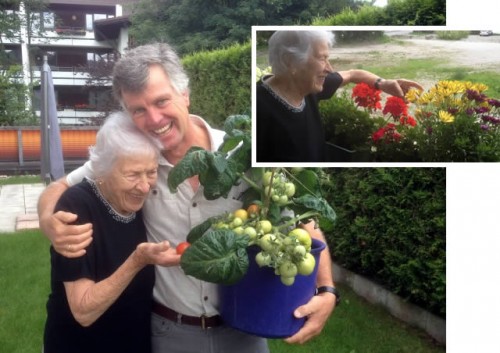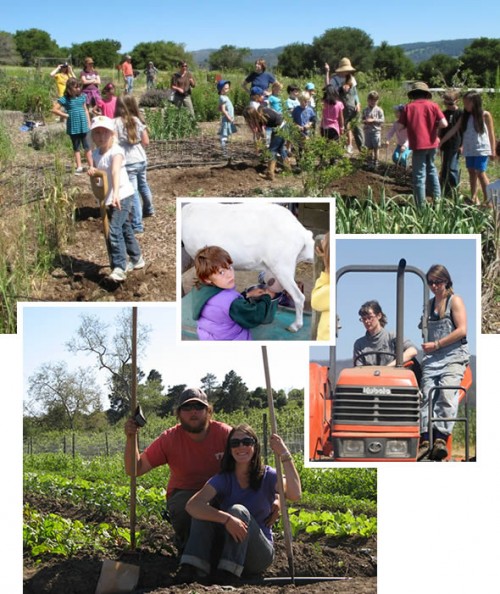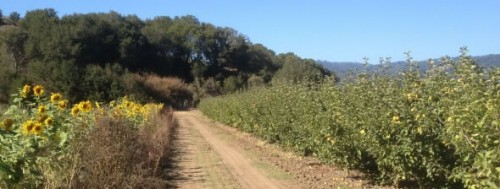 A Dynamic Struggle
A Dynamic Struggle
If you think farming is mostly a peaceful one-with-nature experience, I can assure you, when it comes to weeds it is a battle. Weeds can’t be eradicated since they are much better at what they do than their domesticated cousins we harvest for food. Here on the farm it takes countless hours to control them. We have developed a number of strategies over the years and employ an assortment of handy “weapons”.
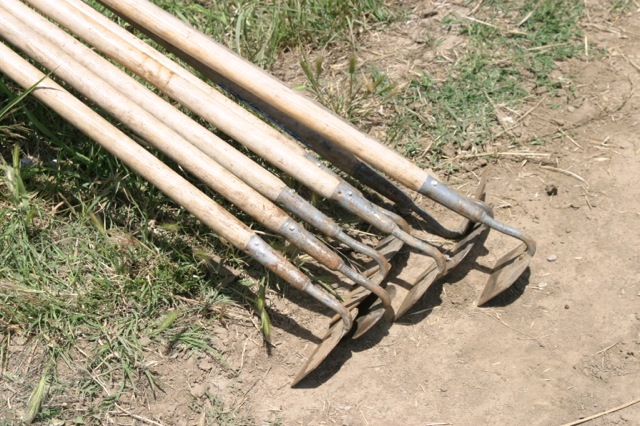
The most low-tech device is the common hoe, of which my favorite is the wheel hoe. It has two-handles with a wheel in the middle and a swiveling stirrup shaped blade. One walks behind it, pushing the wheel hoe allowing the blade to slide and slice just below the surface of the soil effectively decapitating the weeds in its path.
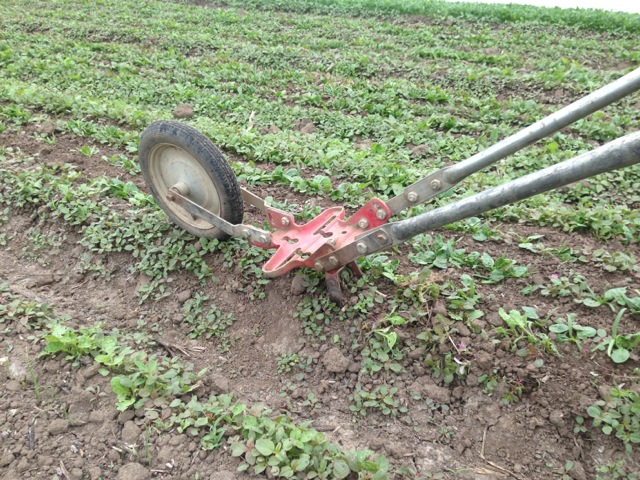
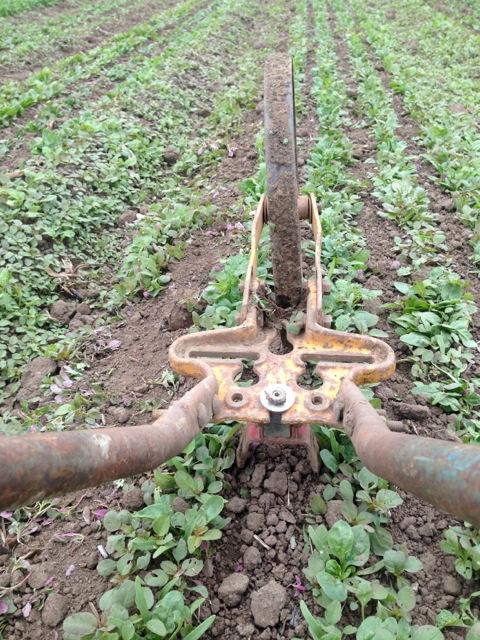
The primary reason to invest in farming equipment is to reduce the time and physical exertion required for many of our daily field tasks. When it comes to weeding with a tractor it requires a specialized assortment of different knives, shovels and discs set up in such a way that they cut, remove and throw soil all at the same time, just inches away from the crop that is growing. Tractor cultivating is almost an art form that takes years of experience. If the timing of soil moisture and the growth stage of both crop and weeds are just right, we can cultivate everything mechanically and avoid the more time consuming and arduous task of hoeing and weeding by hand.
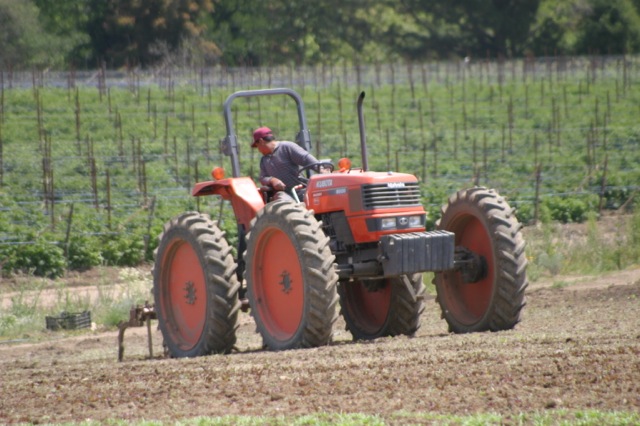
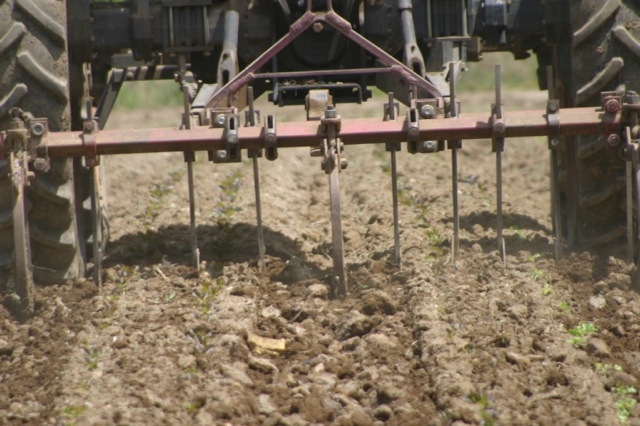
The most impressive weed-fighting tool in our arsenal is the fire spewing flame weeder mounted on the back of a tractor. It uses propane gas to activate four torches, which will flame the entire surface area of two planting beds. We use it to control weeds in carrots, which usually take longer to germinate giving us a chance to control the weeds before the carrots emerge.
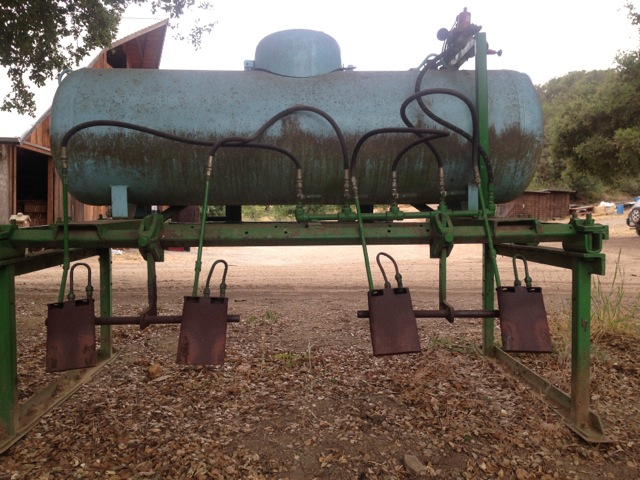
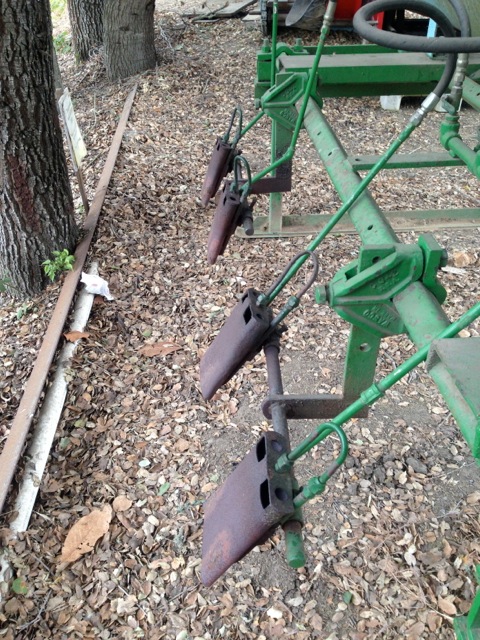
Timing is critical when using a flame weeder. Waiting too long means the carrots will have germinated and we run the risk of burning the carrots with the weeds. This happened to us a couple of weeks ago when a freshly sown patch of carrots decided to germinate on a Sunday, a little earlier than we anticipated. When on Monday morning we decided to flame, the heat of the burners killed the weeds but also the carrot seedlings which were right on the surface of the soil about to push through. As a result, we’ll soon experience a 3-4 week gap in our carrot harvest. Ouch!
To avoid high crop production costs, weeding requires vigilance to effectively determine when weed control is needed in each crop, choosing the best cultivation tools for each crop, and harmonizing weed control tactics with other cropping practices such as irrigation, fertilization, and insect/disease management. Typically we achieve the best results through a combination of hand and mechanical cultivation.
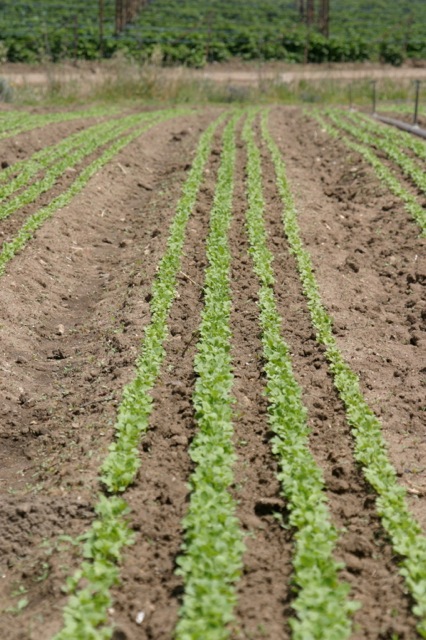
There are times of course when the nature and wildlife proponent in me looks beyond the more adversarial relationship the farmer in me has with weeds, and I see the benefits they have in the farm landscape. Weeds provide habitat and food for beneficial insects, birds and animals. They prevent erosion and contribute organic matter. Many have medicinal (plantain) and nutritional (purslane, lamb’s-quarters) value, and play an intricate part in the web of life here on the farm.
Controlling weeds is like Life itself – it’s a balancing act we constantly struggle to maintain.
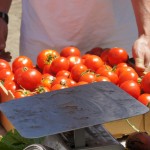 The Farm – A place to taste and inspire
The Farm – A place to taste and inspire
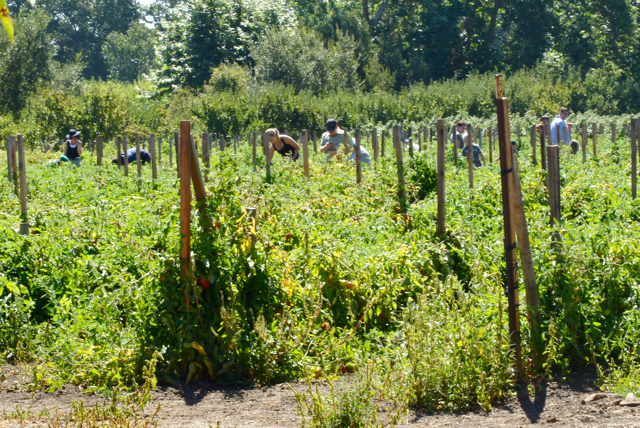
Sammy, his face stained from picking and eating raspberries, came up to me during last Saturday’s Tomato U-Harvest, offering me to taste a berry from a full basket he just picked. “It is a lot of work to pick these”, he commented. I agreed, as I popped a berry in my mouth. “But worth it – they are delicious.”

He then pointed to a stack of boxes filled with tomatoes sitting in the shade of an old Newton Apple tree. “We already have five boxes,” he said excitedly. “Wow, that’s a lot,” I agreed again, trying to spot his parents somewhere among the crowd of pickers. Sammy and his family like to visit the farm and attend our regular community celebrations and farm days. I remember during our last U-Harvest, Sammy didn’t seem to mind the heat while helping his dad harvest Apricots.
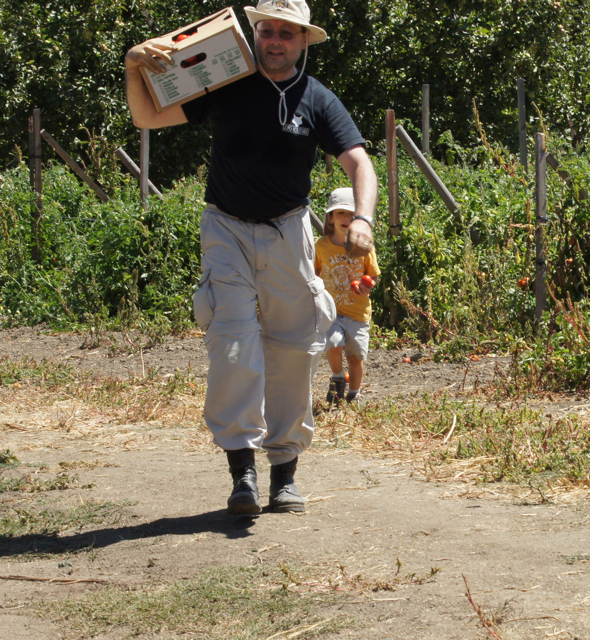
It makes me happy to see children running around, exploring the fields, playing with the farm dogs, the goats and chickens. In today’s Fast Food culture we have gotten so removed from the places and soil where our food is grown that often we are suffering from sensorial deprivation; our senses to touch, smell, and taste food are no longer trained to give us a deeper understanding of the environment, ourselves, and the larger community of life we belong to. Why should any child choose to eat an apple if the only choice is a red or green, waxed and tasteless one sitting next to a bag of “Cheetos”?
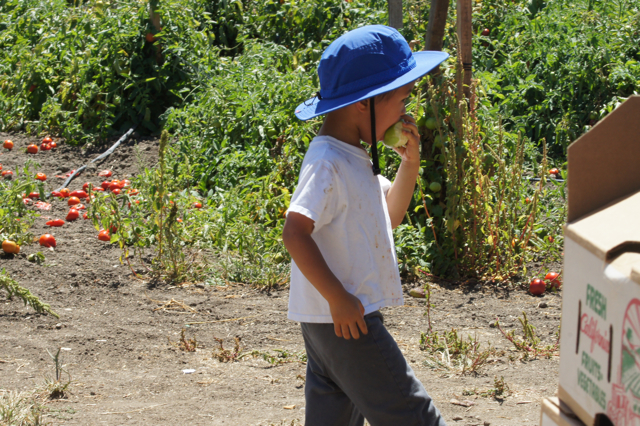
For 18 years now we have focused on offering sustainably grown, healthy and tasty food, and open the farm to our community as a place for teaching about where our food really comes from and learning about the interconnectedness between humans and the larger natural ecosystem. When children like Sammy come to the farm they can engage their senses to discover the pleasures of real food.
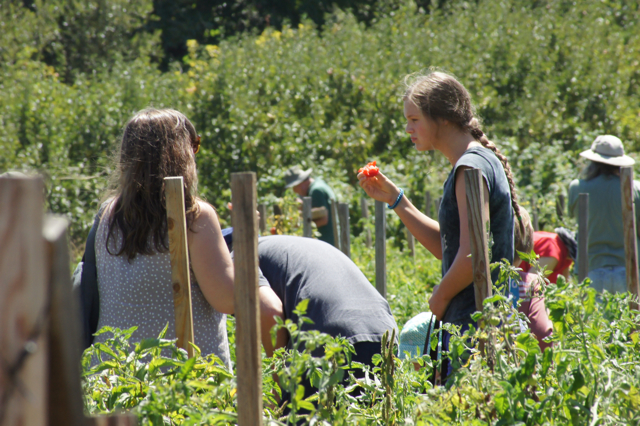
The Live Earth Farm’s Discovery Program has expanded our ability to reach out to children and youth in this county by turning the Farm into a classroom to teach field-to-fork environmental stewardship. Last year over 1400 children and young adults came to the farm, attending farm tours, workshops, summer-camps, and seasonal celebrations. In addition we have on-going programs with the Santa Cruz Montessori School and recently with “Food What?!”, a county youth program organized by UCSC’s Life Lab Program.
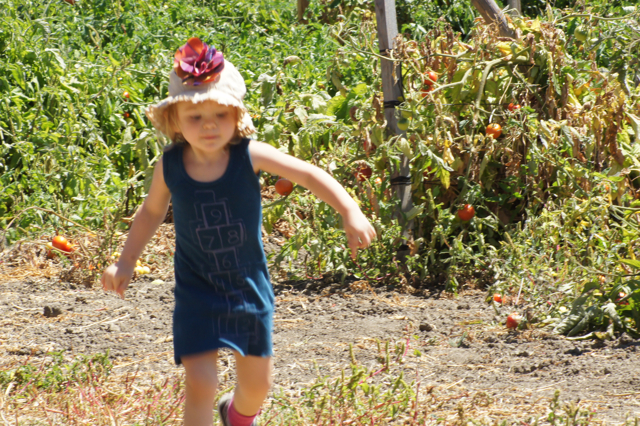
Your commitment and financial support have been essential to strengthen and expand the farm’s educational efforts. Our Annual Fundraiser “SLICE” on September 14th is a great opportunity to show your continued support. If you haven’t done so yet, get your tickets now for one of the farm’s more memorable annual events. “SLICE” will be a unique in-the-Apple-orchard dinner, with wonderful food and entertainment.
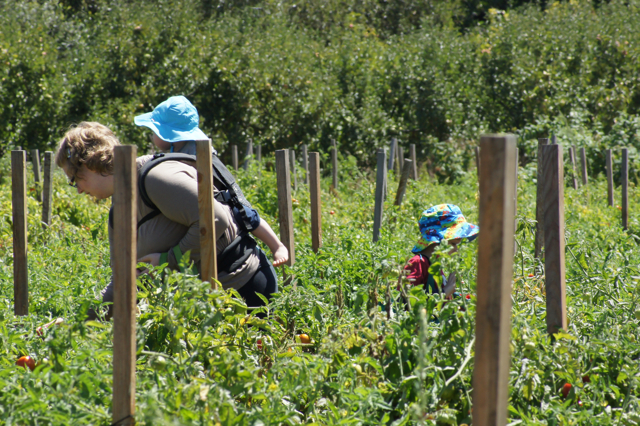
All of the proceeds will go to inspire our next generation of children and youth about how healthy farms and food lead directly to making healthier choices in their own lives and the community they live in. Thanks for your support and I hope you can join us!
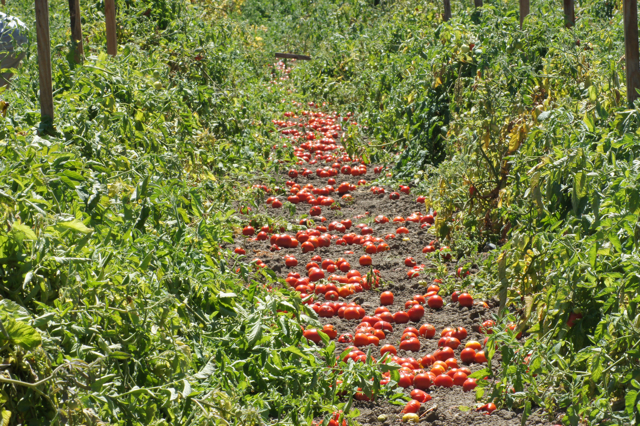
 Food Safety at What Cost?
Food Safety at What Cost?
Holy compost and manure!!!
It’s holy to me and many of my fellow farmers but for many who have lost sight of the vital connection between their daily lives and farming, organic waste is seen as a problem that is dirty and dangerous – not a vital ingredient to build healthy soils and grow nourishing food.
The Food and Drug Administration (FDA) under the newly passed Food Safety and Modernization Act is proposing regulations that would undermine uses of compost and manure currently approved under the National Organic Program. This new regulatory effort has been triggered by food-borne illnesses that have occurred in the last few years, most of them stemming from large-scale food operations.
Currently the proposed regulations seem to be driven more by food safety fear than sound science, leading to ‘sterile’ and ‘scorched-earth’ approaches to the problem. The FDA’s proposed regulations don’t recognize the importance of organic farming and conservation practices as a valuable contributor to reducing the risk of pathogens. Proposed regulations aimed at curtailing the use of compost and manures are based on misguided assumptions, striking at the heart of organic and sustainable farming practices helping to build healthy and fertile soils.
Farming by it’s very nature disturbs the soil, and it is imperative that we don’t loose the tools that help us farmers sustain a healthy balance between growing food and replenishing nutrients and organic matter to support the life and diversity of microorganism in the soil.

A pinch of the Farm’s rich, healthy soil.
Here on the farm we make our own compost by using carbon rich sawdust discarded by a local organic mushroom farm (after they harvest the mushrooms), mixed with organic chicken litter generated by an organic chicken operation down the road from us, and we also add our own vegetable scraps. The blend is moistened and turned many times as it heats up and allowed to go through a 6-8 month composting process transforming the ingredients into a wonderful rich chocolate-like material that has little to do with the initial organic materials we started with.

A couple of the Farm’s compost piles.
All organic matter composts, it’s a natural process in nature, however what seems simple and taken for granted at first sight is very complex and difficult to comprehensively describe in this newsletter (there is plenty of literature on it however). The soils on the farm are an ecosystem alive with mammals (soil burrowing gophers and moles), reptiles (gopher snakes), amphibians (frogs and toads), worms, insects, bacteria and fungi.
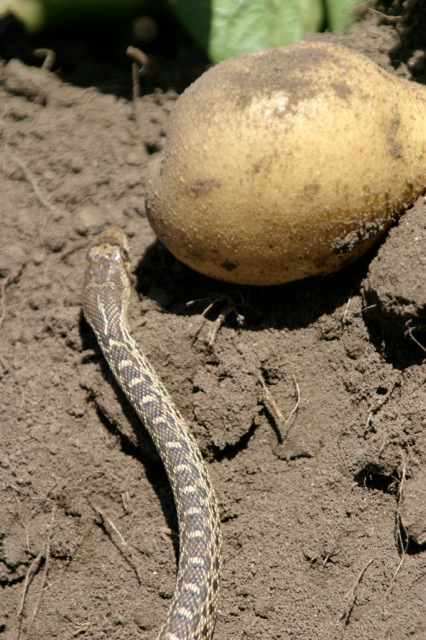
A young Gopher Snake in with the potatoes.
Soil fungi and bacteria break down dead plant and animal matter, making humus in the process and freeing up nutrients. There are billions upon billions of bacteria in the soil, and many plants have symbiotic relationships with both fungi and bacteria that live in and around roots. They deliver nutrients, especially nitrogen, and receive sugars from the roots in return. Many researchers agree that plants, similar to our own bodies, have immune systems that are stronger when a diverse interaction exists with animals, worms, bacteria, viruses, and fungi.
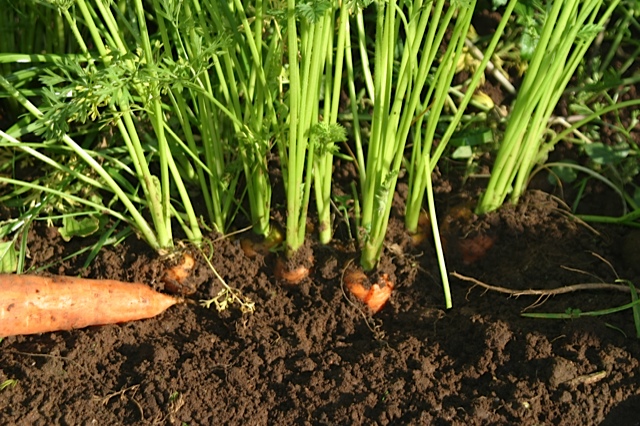
Carrots need healthy, nutrient rich. loamy soil to grow well.
Compost is applied to our fields every year to increase both organic matter and reinvigorate the population of microorganisms that directly contribute to an increase in productivity and healthier plant growth. Biologically active soils are also known to be more efficient at sequestering carbon dioxide by capturing carbon through growing plants and cycling them back into the soil.
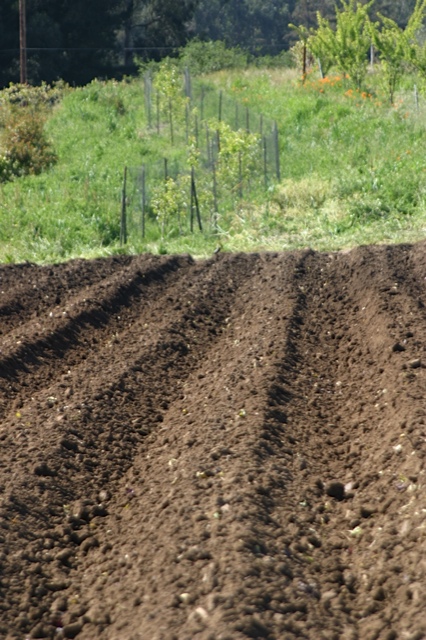
One of the Farm’s recently fertilized and plowed fields.
We are all responsible to ensure a safe food supply from field to our plates but it should not be at the cost of undermining ecologically sound farming practices.
I don’t do this very often but I ask you to please speak up. Everyone who receives this newsletter, please tell the FDA that their proposed regulations should align with the National Organic Program regulations, specifically when it comes to the use of compost and manure. We have until November 15th to submit comments, the link below will connect you to the website of The Wild Farm Alliance which has been actively raising awareness about this issue.
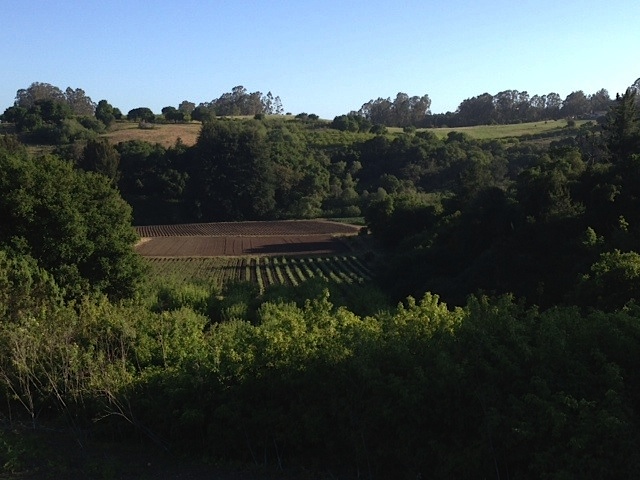
An overview of some of the Farm’s fields and orchards.
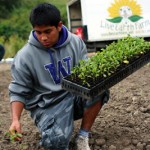 “FOOD, WHAT?!” – Inspiring and Helpful
“FOOD, WHAT?!” – Inspiring and Helpful
Our workload has ratcheted up another notch as summer-crops have started maturing. Green beans, peppers, and cherry tomatoes have been added to the weekly harvest list. The increasing number of tasks mimics the abundance in the field and since most of them are manual by nature, work often starts at dawn and sometimes doesn’t stop until dusk.
Growing fruits and vegetables relies mostly on manual labor, crops are hand-planted, hand-weeded, hand-pruned, hand-picked, hand-dug, hand-bunched, hand-sorted, hand-washed, hand-packed, and then hand-loaded on and off the delivery truck. That’s a lot of handling before and after a seed has metamorphosed into any of the dozen or so produce items in your weekly CSA share.

With all that manual workload you can imagine how welcome a helping hand is at this time of year here on the farm. The last 6 weeks we have enjoyed such help from a wonderful group of teens. Every Friday, at 9 o’clock in the morning, 20 youths from the “Food, What?!” program gather in a circle under the giant oak tree by the barn ready to take on the field tasks scheduled for that day. Planting, weeding or harvesting, these kids don’t shy away from working in the fields.
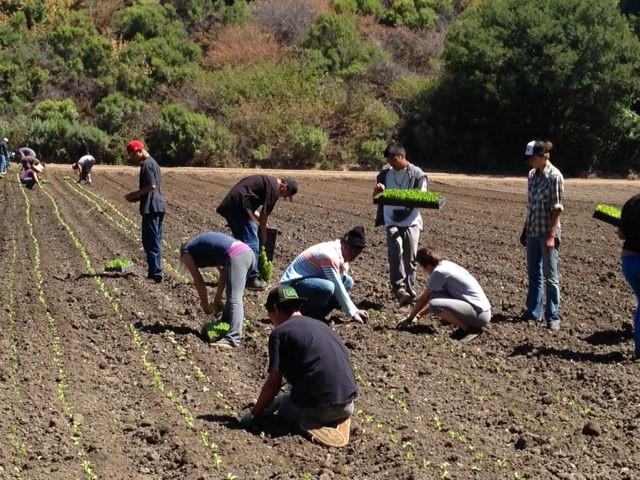
“Food, What?!” I like the name; it’s an important question, one that is at the core of our well-being, the question to understand our connection to food and where it comes from.
Both the Farm’s Discovery Program and “Food What!” share common goals of youth empowerment and farm-based education. On their website “Food What?!” is described as a “… youth empowerment and food justice program using food, through sustainable agriculture and health, as the vehicle for growing strong, healthy, and inspired teens. The program partners with low-income and at-risk youth to grow, cook, eat, and distribute healthy, sustainably raised food and address food justice issues in our community. Youth from Watsonville to Santa Cruz join the FoodWhat Crew through Spring Internships, Summer Jobs, Fall Business Management positions, and leading big community events. It’s an opportunity for youth to engage in leadership development, personal growth, and job training”.
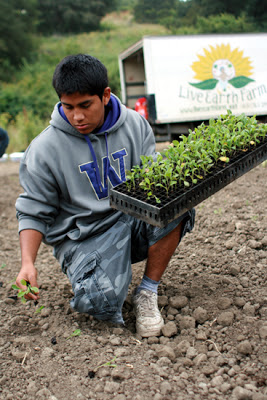
What is exciting and unique about this partnership between Live Earth Farm’s Discovery Program and “Food, What?!” is that the teens can engage in the operation of a real working farm, where they work side by side with 30 hardworking farm employees, experiencing literally from the ground up the fruits of their labor. Whether it’s getting the next succession of kale, lettuce or broccoli in the ground which involves planting thousands of seedlings in straight rows, cutting one hundred 24-count boxes of romaine lettuce, or weeding a 1 acre block of peppers.

At first these tasks sound simple, but once engaged many soon realize it’s not only the physical stamina but skilled hand and body movements and the mastery of a number of specialized tools that are required to do the job well. The teens come to realize that each crop is different, delicate and highly perishable. They come to understand that being a harvester requires different sets of techniques that need to be performed in a timely manner, with attention to quality under often physically taxing outdoor conditions.
Working with the group every Friday has been a real pleasure and a welcome help for the entire farm crew. This upcoming Friday we have planned harvesting potatoes, another big job we are thankful to get some help with.
Check out their website for a photo-essay, capturing a typical Friday at Live Earth Farm
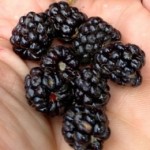 A Taste of the Wild Side
A Taste of the Wild Side
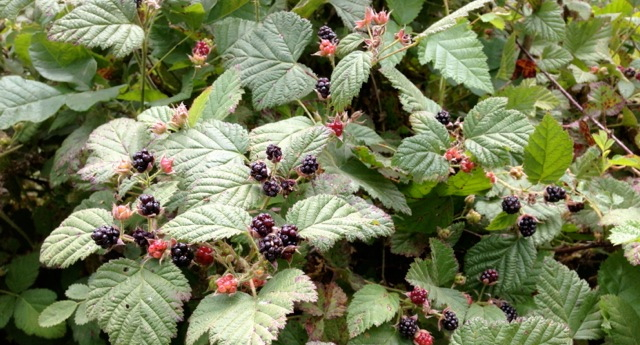
Native Blackberries; Rubus Ursinus
On a farm walk with friends and family this weekend we discovered that many of the native blackberries growing in hedgerows and the understory of our oak woodlands are filled with ripe berries. Unlike the adjacent cultivated field varieties growing in neat domesticated and trellised rows, the native blackberries grow wild among a thicket of other native plants such as Coyote brush, Coffeeberry, Mugwort, Monkey flowers, California Lilac, Sage and many others.

Native blackberries in oak woodland
To pick a handful of these berries may require a series of bends and twists to avoid touching the poison oak or getting pricked by thorns, but it’s worth the effort. Native wild blackberries are a bit more tart and they have a unique bouquet of subtle flavors unlike any of their more domesticated cousins.

Native blackberries and poison oak.
Wild blackberries are never really measured in monetary terms (like price/pound), they are not traded in the marketplace in exchange for paper, they grow wild and are offered freely. As I look down the path where our cultivated patch of blackberries is growing, it strikes me how much of our food production is caught up in the economics of profit and loss, often forgetting to include the value of wilderness in the overall equation.

A happy berry picker.
To gather and taste something that grows wild, uncultivated by any human hand or machine, is a special experience. Most of us are accustomed to thinking of food as a packaged commodity and we forget that the crops we grow have a wild ancestry, which over thousands of years farmers have selected to become today’s food crops.
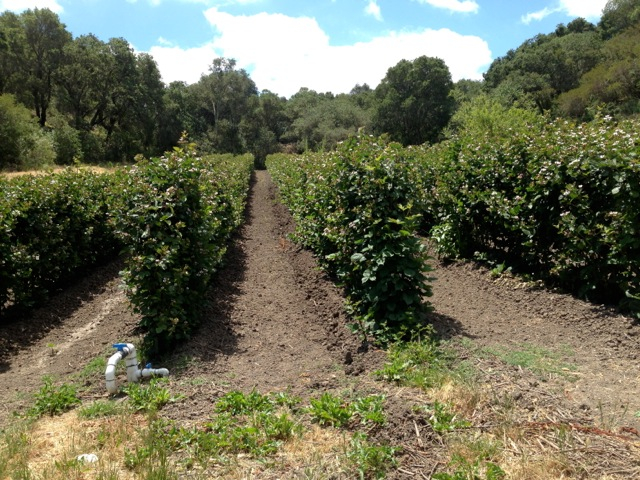
Cultivated blackberries in rows.
Unlike most of our field crops that grow in rows and straight lines, in nature the general pattern is much more random and chaotic, overflowing with curves, corners, knots, and unpredictable twists and turns. Don’t get me wrong, I love the sight of weed-free “linearity” in the fields, it gives a pleasant sense of controlled organization, and straight rows are testimony to a job well done, especially in front of your fellow farmers. In farming we temporarily trick nature into a predictable pattern, to influence the natural process in our favor so that we can enjoy the beauty and bounty of nourishing foods.
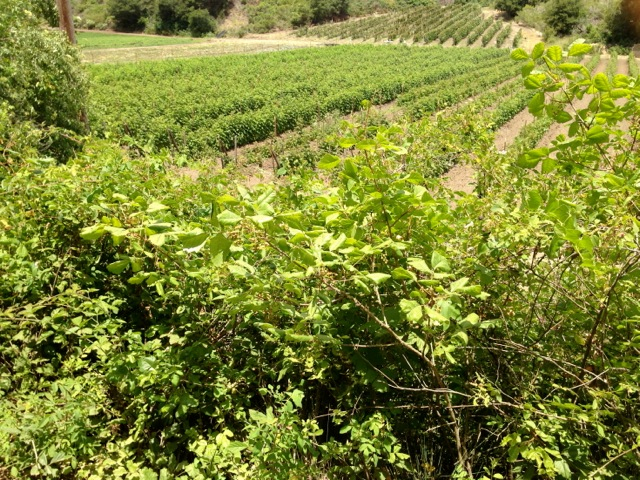
Native blackberries in foreground. Cultivated berries in background.
After picking the wild berries, I walk down the path to taste the first Ollalieberries and it gives me an appreciation of both the wild and the domesticated environments that live side-by-side here on the farm. Both are interdependent and important to manage together.

Cultivated blackberries at top. Native blackberries at bottom.
 Reflections on Seasonality and Favorite Crops
Reflections on Seasonality and Favorite Crops
 Eating with the seasons teaches us patience. Tomatoes may be available whenever I might want at the store, but few things give me greater pleasure than waiting for that special moment in the season when I can harvest and bite into a sun-warmed, vine-ripened, dry-farmed tomato. Although “dry-farming” sounds ordinary, it is actually the culmination of a complex “dance” between farmer and nature. Dry-farming tomatoes is a technique perfected a couple of decades ago by Molino Creek, a farming cooperative situated in the coastal hills above Davenport. We are fortunate to enjoy a similar microclimate. Dry-farming techniques involve proper spacing, soil moisture control, timely cultivation practices, soil rotation and a number of different fertility practices. Under optimum conditions the plants, although stressed from a lack of water, will stay healthy enough to yield, in my opinion, one of the best tasting red tomatoes out there.
Eating with the seasons teaches us patience. Tomatoes may be available whenever I might want at the store, but few things give me greater pleasure than waiting for that special moment in the season when I can harvest and bite into a sun-warmed, vine-ripened, dry-farmed tomato. Although “dry-farming” sounds ordinary, it is actually the culmination of a complex “dance” between farmer and nature. Dry-farming tomatoes is a technique perfected a couple of decades ago by Molino Creek, a farming cooperative situated in the coastal hills above Davenport. We are fortunate to enjoy a similar microclimate. Dry-farming techniques involve proper spacing, soil moisture control, timely cultivation practices, soil rotation and a number of different fertility practices. Under optimum conditions the plants, although stressed from a lack of water, will stay healthy enough to yield, in my opinion, one of the best tasting red tomatoes out there.
“Early Girl” is the variety of choice for dry-farming; it is one of the very few tomato varieties (possibly the only one) that can be dry-farmed. Bred in France in the 1970’s they became an instant hit when they arrived in the United States and today still rank as one of the most popular tomato varieties, especially among gardeners. Tomatoes are not of European origin, quite the contrary; their ancestry can be traced to the impenetrable jungles of Central and South America. The Mayans called it “xtomatl” hence the name tomato. When the Spanish brought the first tomato to Europe it was given the name “pomodoro” (golden apple) and cursed to be poisonous, like some of its relatives in the nightshade family. It was given the botanical name lycopersicum, which means “wolf peach.” The Church condemned eating tomatoes as a scandalous and sinful indulgence and banned it. On the other hand, the French admired its sensuous appearance and were enticed by it, believing that the red fruit had aphrodisiac powers, and so called it “pomme d’amour” or love apple. Not until the 1800s did the tomato finally gain broad culinary acceptance in Europe. Today, we probably couldn’t imagine anything more scandalous than not having tomatoes as part of our diet.
The crop of tomatoes we are now harvesting was sown in a greenhouse in mid-January and transplanted in the field in March. It takes us over 6 months from planting the seed to finally harvesting the first tomatoes. To extend our harvest into the fall, we add two additional tomato plantings staggered 3 and 6 weeks apart. This is true for many of the 50 or so crops we grow every year; many are planted in succession. Timing, plus adjusting to the variables for each successive crop, is what makes our way of farming uniquely challenging. Successional plantings need to fit natural variables such as soil moisture, temperature, and day length, and synchronize with the timing, field rotations and unique growing habits of each crop variety. Although we are only just starting to harvest our summer bounty of crops, we are already well underway in sowing and planting of fall and winter crops: our winter squash was field sown in June, and will take 100-120 days to mature, so they should be ready sometime in early October; fall and winter leeks were sown in the greenhouse in May and transplanted into the field end of July; other fall crops ready to be planted include the beautiful Romanesco cauliflower, Brussels sprouts and Cabbage. And course popular winter root crops such as parsnips, rutabaga and celeriac (celery root) are being sown now so they have enough time to size up before short cold days stop their growth.
 In addition to being patient and flexible regarding “what’s in the box,” CSA members are often asked to be open to trying new types of vegetables. A couple of years ago, for example, we experimented with a new pepper variety – the Padron pepper, and were rewarded with a tasty discovery. Now they have become a staple in our annual production, and will be in the shares with regularity. When my family had this season’s first roasted Padron Peppers a couple of weeks ago, the kitchen filled with that familiar, tantalizing aroma and everyone came to the table with a smile in anticipation of this yummy treat. Even Elisa munched on them, as if the threat of biting into a hot one was of no concern.
In addition to being patient and flexible regarding “what’s in the box,” CSA members are often asked to be open to trying new types of vegetables. A couple of years ago, for example, we experimented with a new pepper variety – the Padron pepper, and were rewarded with a tasty discovery. Now they have become a staple in our annual production, and will be in the shares with regularity. When my family had this season’s first roasted Padron Peppers a couple of weeks ago, the kitchen filled with that familiar, tantalizing aroma and everyone came to the table with a smile in anticipation of this yummy treat. Even Elisa munched on them, as if the threat of biting into a hot one was of no concern.
No one has written a more poetic and humorous story about these Padrons than our neighbor-farmer Andy Griffin, of Mariquita Farm. If you love these peppers as much as I do then you owe it to yourself to read his story, “Pardon my Padróns.” Andy is always one-up on his fellow organic growers when it comes to experimenting with and selecting unusual and great tasting vegetable varieties. So thanks to Andy, and subsequent requests by CSA members and farmer’s market customers, we started growing “Chiles de Padron.” The Padrons are said to have been brought to Spain from Mexico by Franciscan monks in the 16th century, where they were then adapted to the soils and climate of Galicia near the town of Padron, after which the Peppers are named. The town of Padron is located near the Atlantic coast, where today they are grown extensively in a climate probably very similar to ours. The people of Padron best describe the character of these peppers in their native Galician as “Os pementos de Padron, uns pican e outros non.” (Padron peppers, some are hot and some are not.) Indeed, eating Padron peppers is likened to playing Russian Roulette — you never know which one you bite into will be burning hot. Debbie offered to include her description of how they are best prepared. So enjoy, but don’t forget to have something close by to cool your palate should you encounter a hot one!
 Tomatoes (Pomme d’Amour) – the Summer Fruit Everyone Loves
Tomatoes (Pomme d’Amour) – the Summer Fruit Everyone Loves
These last two Saturdays we enjoyed an amazing turnout of people eager to pick their own tomatoes. I am not exaggerating when I say that a couple of tons got picked. Tomatoes were carried away in buckets, carts (Radio Flyers), boxes, bags, coolers and wheelbarrows. I would love to have followed the trail from our fields into peoples’ kitchens, to see how these beautiful summer fruit were being preserved — chopped, sliced, blanched, skinned, boiled, dehydrated, or roasted — for Fall and Winter use. Pickers also explored the surrounding fields, harvesting a diversity of other tasty crops such as our “toe-curling” Sungold cherry tomatoes, peppers, sweet berries, crunchy apples… even sunflower-heads filled with tasty seeds and spicy daikon radishes were taken home by some adventurous harvesters.
Events like these always reaffirm my belief that a farm is more than just a place that grows and sells food. It’s a place where community can enjoy the simple pleasures of picking and eating something right from the field where it is grown and cared for, surrounded by nature. We spend so much time talking about food justice, food security, food safety, food nutrition, food systems… yet that which gives vitality and meaning to the land’s nourishing gifts – food pleasure – is often overlooked. The pleasure we find in food is contagious and speaks to the farmer within us, the one that believes in growing flavorful, fresh, and nourishing food. It speaks to the cook in us who enjoys preparing a delicious meal, and of course it speaks to us eaters (that’s everyone), who undeniably take pleasure in eating and sharing a delicious meal.
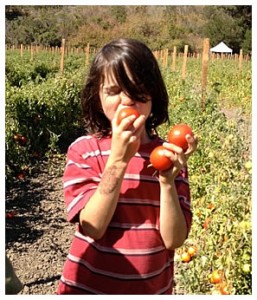 Personally, few things give me greater pleasure than to pick and eat something right in the field, whether it’s a bright red gala apple, a juicy red dry-farmed tomato, a crunchy green bean, or a sun-warmed ripe berry; it is such a simple but deeply satisfying experience. The pleasure we get out of great tasting food is sometimes not acknowledged enough. The guiding principle of our farm is to maintain that intimacy and openness between farm and community, such that we can all experience the pleasure of this nourishing relationship.
Personally, few things give me greater pleasure than to pick and eat something right in the field, whether it’s a bright red gala apple, a juicy red dry-farmed tomato, a crunchy green bean, or a sun-warmed ripe berry; it is such a simple but deeply satisfying experience. The pleasure we get out of great tasting food is sometimes not acknowledged enough. The guiding principle of our farm is to maintain that intimacy and openness between farm and community, such that we can all experience the pleasure of this nourishing relationship.
Enjoy these last few weeks of summer and come out to the farm while tomatoes are still plentiful. You are welcome to pick by yourself during our regular Saturday Farm stand hours between 10am-3pm. Another great opportunity to enjoy and support the farm is during our upcoming events. The Live Earth Farm Discovery Program’s Fundraiser is on September 22nd, a not to be missed, in-the-field Culinary Feast; there’s also an Apple U-pick and Fresh Cider Pressing Community Farm Day on September 29th, and our End-of-Season Harvest Fest on October 20th.
Hope you can all come and enjoy “YOUR” Farm.
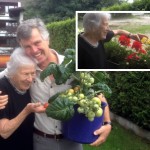 The Farmer and Gardeners Hidden within Us All
The Farmer and Gardeners Hidden within Us All
At 91 years of age my mother’s love for and excitement about growing plants has not diminished, even though her gardening space is now reduced to the sunny side of a small apartment. When I visited my parents last week, she proudly showed me her first tomatoes, picked from her three tomato plants growing in large pots in a corner of her terrace. Her “garden” this year consists of a couple planter boxes of her favorite herbs and salad greens, and I wasn’t surprised to see the balcony outside her kitchen bursting with colors from her favorite flowers.
When I was growing up, the kitchen and garden were always closely connected; my favorite place to play was right outside the kitchen door. I was lucky enough to enjoy the company of several domesticated animals including chickens, dogs, parrots, guinea pigs, and rabbits. We had a large eucalyptus tree with a tree house to climb around in. We also had many different fruit trees, so I could harvest and eat directly from the garden to my heart’s content. Hedges, shrubs and a vacant lot adjacent to our garden provided the “wild” exciting places for me to explore and hide in. I always liked helping my mother in the garden, especially sowing seeds and then eagerly waiting for them to germinate. Harvesting something from the garden was always special as well, and I loved bringing the things I picked into the kitchen where they would then be cleaned and prepared into a dish for the next meal or preserved for later use. Our garden was like a little sanctuary, a place to play and spend time with friends and family; there’s no question it inspired my later interest in farming. In some ways Live Earth Farm is an extension of that childhood experience — a place with an abundance of plants, animals and diverse landscapes where community is built around growing healthy seasonal fruits and vegetables, and transforming the harvest into meals shared with family and friends is a natural extension of the process.
A little over a hundred years ago, agriculture was not only the major source of income in this country, it was the center of every community, providing sustenance, social interaction, and lively mealtime conversations around the dinner table. In the early 1900’s more than 30% of the US labor-force were farmers. Today the U.S. census has stopped counting farmers since only 2% of the workforce — less than a million people — are farmers. It seems like we’ve reached an extreme, where the majority of the population buys their food in the supermarket (much of it processed, with little evidence of its source). But this “fast food” mentality is starting to crumble; many people are again making the conscious link between nutrition of our bodies and the health of our environment. One indicator is that all across the country there is a resurgence in gardening, focused on growing food at schools, in vacant lots in and around urban centers, at home… even the White House has an (organic!) vegetable garden, which is supplying the First Family’s kitchen. This popularity in gardening of course has its many reasons. Motivations include the desire to improve our diet, to enjoy fresher and better tasting fruits and vegetables, for convenience, to learn to cook with the seasons, to lower grocery bills, to create time to spend with the family… sometimes it is just done for the sheer pleasure of growing something and/or bartering/sharing the surplus with friends and neighbors.
Although the ‘less than 2% of US population is a farmer’ statistic — combined with the average age of today’s farmer being over 55 — is alarming, there is evidence that it’s not due to a lack of interest in farming. According to a recent article published by Cornell’s Small Farm program, one of the most popular video games on the market is called “Farmville”, with over 80 million people here in the United States currently signed up and playing it. That is amazing… 80 million people! This just shows that the interest in farming is alive and well, that there is a farmer or gardener hidden somewhere in all of us, even if only in the “cool” world of virtual farming. Suddenly I can see Community Supported Agriculture turning into a movement, where knowing your farmer, growing your own, and/or going to farmers markets is mainstream, the norm. (Farmers market attendance alone has doubled from 2011 to 2012.) I am sure this is possible, that a much larger percentage of people will be more passionate and excited about farming for real. It might just be the trend of the future, who knows?
For the last 16 years we have offered young people the opportunity to experience what life on a farm is like, by providing the hands-on experience of running a farm, from planning and organizing to growing, harvesting, selling and delivering quality produce to the community. Many apprentices have moved on to start their own farms or engage in careers that help build sustainable food systems. Live Earth Farm’s Discovery Program hosted more than 1400 children last year, using the Farm as a classroom to teach field-to-fork environmental stewardship. The farm is an ideal venue for teaching about where our food really comes from, and for learning about the interconnectedness between humans and the larger natural ecosystem. As CSA members and friends of the farm, your commitment and financial support have been essential to the strength and development of the farm’s educational efforts.
I would like to encourage everyone to support us this year so we can expand our programming and outreach and continue to inspire the next generation of young farmers and gardeners. If you haven’t done so yet, I want to invite you to get your tickets now for one of the farm’s most memorable annual events: our annual fundraiser dinner. This year, “DIG”, the in-the-field dinner (September 22nd – details below) will be in an amazing setting here on the farm, with incredible food and entertainment. The best part, though, is that all of the proceeds will go to inspire the next generation of new farmers and gardeners growing food directly in and for their communities. I hope you can join us!
Below, farmers of all ages at Live Earth Farm, from kids working in the Discovery Garden, to trying their hand at milking a goat, to apprentices learning how to use a tractor; at bottom are Jeff and Anna, last year’s “Young Farmer” team, who have since married and gone off to start a farm of their own…
 Summer to Fall – When Seasons Collide
Summer to Fall – When Seasons Collide
 We are now officially in our last week of Summer. September 21st marks the Autumn Equinox, and the beginning of fall. It is an odd time of seasonal overlap; we are reaching the peak of the Summer season harvest-wise, yet the foliage on plum trees and native poison oak is changing to red, the daily number of eggs collected are dropping and pumpkins are turning orange. Everyone working on the farm has turned into an “acrobat” juggling a larger number of tasks than usual. Nothing is more telling of this seasonal transition, however, than when we are fully immersed in our apple harvest. Trees hang heavy with beautiful green, yellow, orange, and red, apples. Gala’s are at their peak of ripeness. Harvest bins line the orchard floor, some empty, others filled to the brim. Filled bins are hauled out – some get sorted and washed for immediate use, while others go into cold storage to be sorted and processed later.
We are now officially in our last week of Summer. September 21st marks the Autumn Equinox, and the beginning of fall. It is an odd time of seasonal overlap; we are reaching the peak of the Summer season harvest-wise, yet the foliage on plum trees and native poison oak is changing to red, the daily number of eggs collected are dropping and pumpkins are turning orange. Everyone working on the farm has turned into an “acrobat” juggling a larger number of tasks than usual. Nothing is more telling of this seasonal transition, however, than when we are fully immersed in our apple harvest. Trees hang heavy with beautiful green, yellow, orange, and red, apples. Gala’s are at their peak of ripeness. Harvest bins line the orchard floor, some empty, others filled to the brim. Filled bins are hauled out – some get sorted and washed for immediate use, while others go into cold storage to be sorted and processed later.
Everyone visiting the farm loves the experience of picking and eating apples directly from the trees or using the farm’s cider press to crush and press the freshly harvested apples into delicious sweet cider. Few experiences are more satisfying to me than biting into a fully tree-ripened apple; it is yet another pleasure of experiencing our relationship with the nourishing cycle of nature. If you’re not a farmer though, you probably are not aware of what all goes into producing that sweet, crisp fruit. An apple orchard needs year-round attention, and the perennial cycle is very different from the annual, season-focused vegetable crops we grow. Apples lean heavily on human help and it takes a lot of devotion, from winter pruning through post-harvest cleanup in late Fall.
Apples thrive in our climate. One wouldn’t think by driving through the Pajaro Valley that this was once one of the largest apple growing districts in the country. Most of the apple orchards have been pushed over by bulldozers, replaced by the more lucrative berry, vegetable and flower crops. The predominant variety then was the Newtown Pippin, a variety originally from New York, introduced by settlers in the 1850s. Today it is still the trademark apple in Martinelli’s popular apple juice, processed here in Watsonville, and probably the reason why Newton Pippins are still grown commercially in this area.
 Here on the farm we grow approximately 7 acres of apples, mostly Fuji, Gala, Sommerfeld and a few Newton Pippins. Starting in winter, the dormant season, trees first have to be pruned, and then sprayed with oils or sulphur before and after budbreak to fend of insect and fungal diseases. Pheromone wires have to be tied to the trees at a precise time in the spring to confuse the mating cycle of codling moths which will greatly reduce worms from hatching and burrowing into the apples. Once the soil dries the orchard needs to be cultivated, both to control weed competition and trap valuable winter moisture in the ground. In April, beehives are brought in to ensure good pollination and after a successful fruit set, the entire months of May and part of June is spent hand thinning trees to ensure fruit will develop into a marketable size. The first seasonal watering happens sometime in June and propping up branches to support the increasing weight load of the fruit is critical during the early summer months.
Here on the farm we grow approximately 7 acres of apples, mostly Fuji, Gala, Sommerfeld and a few Newton Pippins. Starting in winter, the dormant season, trees first have to be pruned, and then sprayed with oils or sulphur before and after budbreak to fend of insect and fungal diseases. Pheromone wires have to be tied to the trees at a precise time in the spring to confuse the mating cycle of codling moths which will greatly reduce worms from hatching and burrowing into the apples. Once the soil dries the orchard needs to be cultivated, both to control weed competition and trap valuable winter moisture in the ground. In April, beehives are brought in to ensure good pollination and after a successful fruit set, the entire months of May and part of June is spent hand thinning trees to ensure fruit will develop into a marketable size. The first seasonal watering happens sometime in June and propping up branches to support the increasing weight load of the fruit is critical during the early summer months.
Then it’s time to prepare for harvest: bins needs to be placed among the trees in the orchard rows, and from early September until late October we hope to be rewarded with a high percentage of beautiful fruit. As soon as the fruit is harvested and windfalls are picked off the ground, it’s a race against time to prepare the orchard for the wet winter months ahead, spreading lime, gypsum and compost, collecting the propping stakes and tying them to the trees, and sowing a cover crop of barley and vetch.
For a brief while longer we can ignore all the early Halloween merchandise and enjoy our summer treats as nature changes into her colorful autumn dress. On the farm, a stand of blooming sunflowers are tilting their giant heads towards a row of yet-to-be-picked Newton Pippins, as if anticipating the seasonal change. The energy in plants is starting to move toward the roots and seeds, and leaves are falling as their life forces go within. By eating with the seasons, we participate in this journey with all other living organisms we share this planet with. Happy Fall Equinox to all of You!
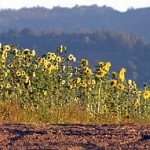 When Seasons Collide – Redux
When Seasons Collide – Redux
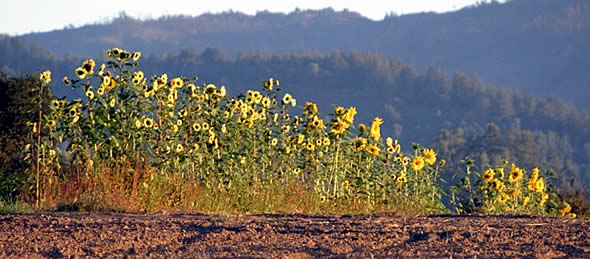 With October here, our Coastal Summer has arrived… but will it last? Late season heat waves are not uncommon, but for coastal growers like us, spoiled by year-round moderate temperatures — when yesterday’s thermometer hit a blistering 100 degrees it was a scramble to adjust irrigation, planting and harvest schedules to deal with it. Growing a diversity of crops is always a mixed blessing; some thrive, while others get stressed. Tomatoes, peppers, green beans and squash will get a late season boost from the heat, but ripening apples and berries may get sunburned. And insects, especially aphids and flea beetles which thrive in warm weather, will probably multiply on some of their favorite host crops (cauliflower, Brussels sprouts, broccoli) which have already been planted for late fall and winter harvest. Fortunately this time of year there are plenty of beneficial predator insects which will help keep the population of aphids down. We also use physical barriers to limit pest incursion, such as putting floating row cover over the young and more vulnerable arugula and Brussels sprouts. By week’s end this heat wave will be a distant memory, as the first chance of showers for our area is predicted. If it materializes, it will quench a very thirsty, dry landscape.
With October here, our Coastal Summer has arrived… but will it last? Late season heat waves are not uncommon, but for coastal growers like us, spoiled by year-round moderate temperatures — when yesterday’s thermometer hit a blistering 100 degrees it was a scramble to adjust irrigation, planting and harvest schedules to deal with it. Growing a diversity of crops is always a mixed blessing; some thrive, while others get stressed. Tomatoes, peppers, green beans and squash will get a late season boost from the heat, but ripening apples and berries may get sunburned. And insects, especially aphids and flea beetles which thrive in warm weather, will probably multiply on some of their favorite host crops (cauliflower, Brussels sprouts, broccoli) which have already been planted for late fall and winter harvest. Fortunately this time of year there are plenty of beneficial predator insects which will help keep the population of aphids down. We also use physical barriers to limit pest incursion, such as putting floating row cover over the young and more vulnerable arugula and Brussels sprouts. By week’s end this heat wave will be a distant memory, as the first chance of showers for our area is predicted. If it materializes, it will quench a very thirsty, dry landscape.
 Looking ahead, the winter squash is stellar and I predict we’ll have a bumper harvest of four of my favorite types: Delicata, Butternut, Kabocha (pictured at right), and Sweet Dumplings — all great to cook with. The pumpkins are also quickly turning bright orange, just in time for our harvest celebration (see announcement). The concord grapes are sweet and fragrant and so are the Quince. Fields are being prepared for end-of-season plantings of strawberries, garlic, onions, artichokes and cover crops. October is always a time of seasonal transition; we are holding on to the last of our summer crops, the Newton Pippin and Fuji apple harvest is in full swing, apricot trees need to be pruned, winter squash needs to be harvested… we all feel a little nervous as the season slowly turns and the chance of early storms, announcing the beginning of the rainy season, is not far off.
Looking ahead, the winter squash is stellar and I predict we’ll have a bumper harvest of four of my favorite types: Delicata, Butternut, Kabocha (pictured at right), and Sweet Dumplings — all great to cook with. The pumpkins are also quickly turning bright orange, just in time for our harvest celebration (see announcement). The concord grapes are sweet and fragrant and so are the Quince. Fields are being prepared for end-of-season plantings of strawberries, garlic, onions, artichokes and cover crops. October is always a time of seasonal transition; we are holding on to the last of our summer crops, the Newton Pippin and Fuji apple harvest is in full swing, apricot trees need to be pruned, winter squash needs to be harvested… we all feel a little nervous as the season slowly turns and the chance of early storms, announcing the beginning of the rainy season, is not far off.
– Tom


